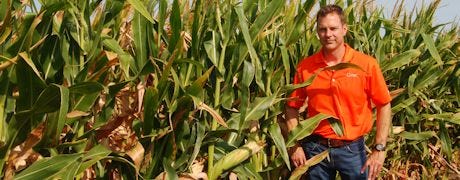
Earlier this fall, Wallaces Farmer had the opportunity to visit with Myron Stine of Stine Seed Company at the company's headquarters at Adel, Iowa. The company is doing a lot of on-farm work with narrow row corn. It's beyond the "research stage." This year they had a number of their customers across the U.S. plant some corn at high populations in ultra-narrow rows of only a 12-inch row width. They've been using the 12 -inch row spacing on some of their own corn ground in central Iowa for several years. But in 2013 the company planted all their corn in a 12-inch row width on the entire farming operation of Stine Seed.

ULTRA-NARROW ROW CORN: Most corn in the U.S. Corn Belt today is planted at around 30,000 plants per acre and in a 30-inch row width. Some seed corn companies are planting high population densities—in the 45,000 to 50,000 plants per acre range—to test different hybrids and see what the results are. To get high population densities, they plant corn in an ultra-narrow row spacing of only a 12-inch width.
"We had about 15,000 acres this year in the 12-inch rows," said Myron. "Both corn and soybeans." He said the ultra-narrow rows have performed well. Stine's ultra-narrow row corn was the subject of the cover story on the November issue of Wallaces Farmer magazine in 2012. In an upcoming issue of Wallaces Farmer, we'll have an update on how the corn and soybeans in 12-inch rows yielded in 2013.
Stine Seed is testing all of the company's new genetic corn hybrid combinations in high population field environments. The company wants to keep the genetic material that performs well in high populations. "We are strong believers that the future of high yielding corn will be higher populations," says Myron Stine. He explains that Stine corn hybrids in the company's development program, called Elite Trials, are planted in three different populations. It's about 50,000 plants per acre for the middle. For the low end of the testing range it's 45,000 plants per acre and for the high it's about 55,000. Stine wants to find germplasm that performs well as the population is increased.
Learn more about Stine's results with ultra-narrow rows at www.stineseed.com.
The vast majority of corn acres in the U.S. and Canada are currently planted in 30-inch rows (85%), with narrow row spacing (less than 30-inches) used on fewer than 5% of corn acres. Regional adoption of narrow rows varies widely, with highest adoption rate in northern Corn Belt states of Minnesota, Wisconsin, North Dakota and South Dakota.~~~PAGE_BREAK_HERE~~~
Mark Jeschke, DuPont Pioneer agronomy research manager, indicates the primary rationale for narrow row spacings in corn is that by reducing the crowding of plants within a row, the crop will be able to better utilize available light, water, and nutrients by reducing competition among individual plants.
Here's what another seed company headquartered in Iowa has to say about narrow-row corn
Over the years, research on narrow row corn has produced variable results, which suggests that multiple factors likely influence corn yield response to row spacing, says Jeschke. Yield benefits with narrow row corn have been observed more frequently in the northern portion of the Corn Belt. Even among northern locations, however, yield benefits to narrow rows were inconsistent.
For example, a university study during 2009 and 2010 found no yield advantage to narrow rows at two southern Minnesota locations. While a survey of several recent university corn row studies comparing narrow rows to 30-inch rows, found an average yield advantage of 2.8% with narrow or twin rows was observed in northern studies, compared to no advantage on average (-0.2%) for narrow rows in Iowa, Indiana and Nebraska.
Research on corn row spacing over the years has shown that it is a very complex issue with many interacting factors
Similar results have been observed in DuPont Pioneer research. Results from76 research studies conducted by Pioneer between 1991 and 2010 showed an average yield advantage of 2.7 percent with narrow or twin rows in the northern Corn Belt states compared to a 1% advantage across studies in the central Corn Belt.
DuPont Pioneer recently issued a press release on narrow row corn. Here are the final two concluding paragraphs: The extensive history of research on corn row spacing has repeatedly shown that it is a very complex issue with many interacting factors. Yield results have often been inconsistent and highly variable across environments, making it difficult for growers to determine the best solution for their individual farms.
However, the accumulated body of DuPont Pioneer and university research conducted over the past 20 years does not indicate that the current standard 30-inch row spacing is limiting to corn productivity for most of the Corn Belt. This research also provides little evidence to suggest that narrow rows will consistently increase yield relative to 30-inch rows on productive soils under current agronomic practices.
About the Author(s)
You May Also Like




